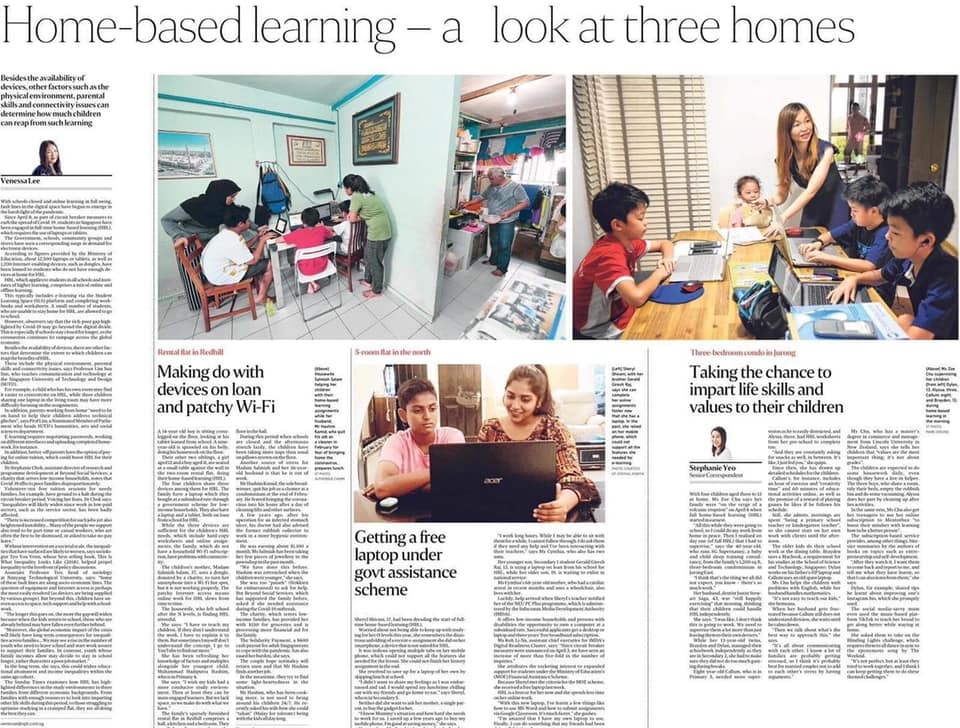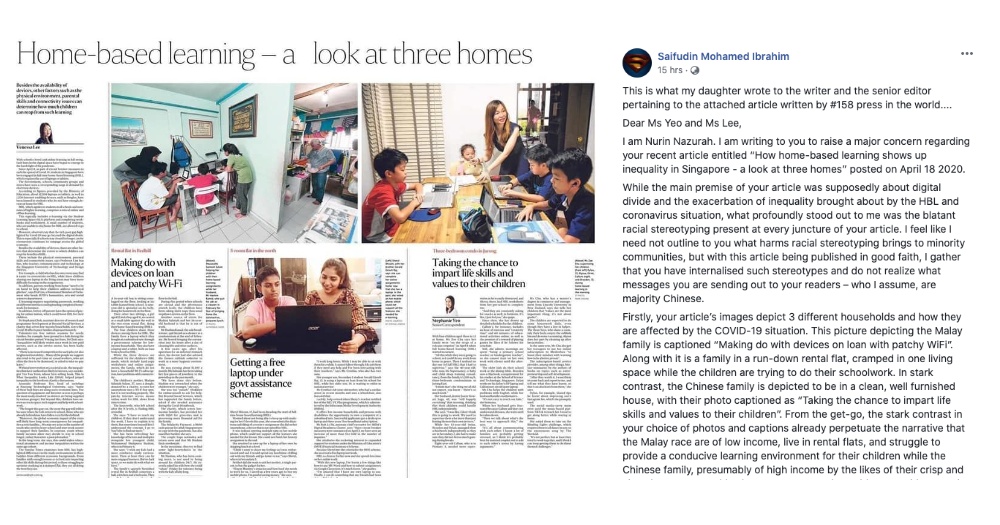The Straits Times ran a report on April 18 about home-based learning (HBL) in three different households in Singapore during this Covid-19 circuit breaker period.
What was the report about?
The focus of the report was on how HBL, as it is being carried out in different households, inevitably end up revealing the inequality in existence given the disparity in access to resources.
What did the article show exactly?
The ST article depicted three families and laid out how a well-to-do Chinese family, and low-income Malay and Indian families were handling HBL.
 Image via Saifudin Mohamed Ibrahim on Facebook
Image via Saifudin Mohamed Ibrahim on Facebook
What sort of reactions have the article received?
The ST article has since received backlash from many minorities over what they perceive to be a perpetuation of racial stereotypes in the country.
One response explicitly called out the framing of the issue:
https://twitter.com/DanRosli/status/1252453456964534273
While two Facebook posts also called attention to the issue:
On April 23, one Saifudin Mohamed Ibrahim took to Facebook to share a letter his daughter, Nurin Nazura, had written to the writer and editor of the ST article.
What did the letter say?
In her letter, Nurin wrote that there was “blatant racial stereotyping present” at “every juncture of the article”, even though the main premise was “supposedly about digital divide and the exacerbation of inequality brought about by the HBL and coronavirus situation”.
According to her, the Malay family in ST's article was depicted in a “run-down rental flat, cramped in one living space while the children are trying to do their schoolwork”.
The accompanying caption, “Making do with devices on loan with patchy WiFi”, did not do favours painting the Malay family in a better light either.
The Chinese family, on the other hand, was depicted in a “a clean, well furnished house”, with their photo accompanied with the sub-headline, “Taking the chance to impart life skills and values to their children”.
Nurin argued that ST‘s choice of photos and captions perpetuate the narrative that Malays are of “low income, live in rental flats, and struggle to provide a conducive learning environment for their children”.
This is in stark contrast to the depiction of the Chinese family, who are “presumably of high income by the likes of their crisp and clean home” and have the resources to “provide a good educational environment for their children”.
She then argued that “Malays, Indians and Chinese have always been categorised into these labels”, and more often than not, it is the “Malays and Indians who are given such disparaging and degrading labels, making people think that they are inferior to the Chinese race”.
Nurin added that such a seemingly harmless piece on inequality in Singapore “reinforces disparaging and harmful stereotypes towards racial minorities who already suffer from discrimination due to these long held stereotypes”.
Stark difference in Chinese and Malay parents' educational qualifications and capabilities
Nurin also claimed that ST‘s choice of narrative “further betrays this stereotypical mindset”.
This was so as the paper chose to feature Chinese and Malay parents with a “stark difference” in “educational qualifications and capabilities”.
For example, the Chinese mother in the article runs a consultancy company and is described to be a “dedicated parent” who goes out of her way to “draw detailed schedules for her children to ensure they have a balance of play and study time”.
She is depicted to be in a “productive partnership” with her husband, a dentist, who “also pulls his weight in helping his children with schoolwork”.
In contrast, the Malay father in the article is “currently jobless" and his wife’s highest education is N-level.
Furthermore, the Malay father was also depicted as being much less dedicated and devoted to spending time with his children.
A quote in ST‘s article showed he had “asked his wife how she could tahan (Malay for tolerate) being with the children all day long”.
According to Nurin, this reinforces the stereotype that Chinese parents are “still able to be devoted parents and be involved in their children’s lives” on top of juggling their prestigious full-time jobs.
On the other hand, Malay parents who work in menial, low wage jobs, are “less devoted to their children and have less parental attachment towards them”.
This, Nurin wrote, perpetuates stereotypes about the types of jobs each racial category holds, and depicts Chinese parents as superior to Malay parents.
Stereotypes have caused hurt and discrimination
Nurin also argued that ST could have chosen any family to portray the inequalities present in Singapore, such as “Chinese families in rental flats” and “wealthy Malay or Indian families”.
However, their choice of depiction reflects the “racial segregation and stereotypes” that have long hurt and caused discrimination towards racial minorities, she said.
She also cited an Institute of Policy Studies survey from 2018, in which “52 per cent of Malay respondents and 47 per cent of Indian respondents stated that they faced racial discrimination when applying for a job”, and claimed that these harmful stereotypes have “perpetuated inequalities in both the treatment and job prospects of these minorities”.
Nurin called such a reinforcing cycle the “dire reality” that minorities face, which Chinese people may not be able to comprehend.
Nurin ended her letter by writing that ST‘s article is “complicit in perpetuating further racial inequality” and is “damaging and hurtful to racial minorities”.
She and others, she wrote, “do not fall into these categorisations and stereotypes, and do not appreciate being reduced into such a belittling and inaccurate labelling of our race”.
She had stated early in her response that the national paper had "internalised" such stereotypes.
The Straits Times apologises for article
On April 25, ST put out an apology in response to a forum letter by Walid Jumblatt Abdullah, an assistant professor at Nanyang Technological University's School of Social Sciences.
According to Walid, ST's article was "a reflection of, and contributes to, racial stereotypes about the "successful Chinese" and "worse-off minorities".
He added that "continued portrayals of minorities as worse-off can belie the fact that other factors, including class differences, contribute to the perpetuation of these inequalities."
According to ST, their feature was "aimed at reflecting how various families were dealing with home-based learning and not intended to have any racial connotations."
They also thanked Walid and others who had "voiced concerns about how the stories might have been perceived" and apologised for "any offence caused inadvertently".
Top image via Straits Times and Saifudin Mohamed Ibrahim on Facebook
If you like what you read, follow us on Facebook, Instagram, Twitter and Telegram to get the latest updates.
